Since the Ming Dynasty, there has been a saying that "the head of the ox in spring and the clouds in autumn"."Qixia Danfeng" is one of the 40 scenic spots in the new Jinling. The Maple Ridge on the west side of the mountain has patches of maple trees, which is the main attraction for tourists in Qixia Mountain. Scenery, one of the four major maple attractions in China. Every late autumn, the mountains are covered with red, like sunset, which is spectacular. When we arrived in Qixia, we mainly came to admire the maple leaves and admire the beautiful scenery of the forest...


Qixia Mountain is known as the "Famous Site of the Six Dynasties". In the Qing Dynasty, it was listed as one of the "Forty-eight Scenery Scenery of Jinling" and is known as "a Qixia Mountain, half of the history of Jinling." In history, five kings and fourteen emperors once climbed Qixia Mountain, and there are more than 80 historical monuments and sites, gathering religious culture, emperor culture, green culture, celebrity culture, geological culture, stone carving culture, and tea culture. The thousand-year-old temple, the ancestral courtyard of the "Three Arguments" of Buddhism, and the ancient Qixia Temple, one of the "Four Jungles" of Buddhism, are located at the western foot of Qixia Mountain.

Mingjing Lake Mingjing Lake is located to the west of the gate of Qixia Temple, covering an area of about 3000 square meters. It was built during the Qianlong period of the Qing Dynasty. There is a lake-center pavilion in the lake and a nine-bend bridge connected to the bank. It is exquisite in shape. The scenic spot is named "Rainbow Mirror" and there is a "Rainbow Mirror" monument stands by the lake. There is a crescent pond to the east, and then there is the gate of Qixia Temple.





Qixia Mountain was called Shushan in ancient times, also known as Sanshan Mountain. In the Southern Dynasties, there was a "Qixia Jingshe" built on the mountain, hence its name. Qixia Temple covers an area of more than 40 acres. There are three services in the Pilu Hall and the Sutra Tower. It rises layer by layer according to the mountain, and the layout is neat and beautiful. In front of Qixia Temple is an open green lawn, with a mirror lake with waves as flat as a mirror and a white lotus pond shaped like a crescent moon. It is surrounded by lush trees and flowers. In the distance are winding peaks. The air is fresh and the scenery is quiet and beautiful. The main buildings in the temple include the mountain gate, Maitreya Buddha Hall, Pilu Hall, Dharma Hall, Buddha Reading Hall, Sutra Building, Jianzhen Memorial Hall, and relics Pagoda. In front of the temple, there is a Monument to the Lord of Minghui, and behind the temple are many scenic spots such as Thousand Buddha Rock.

On the left side in front of the temple, there is a monument to the Lord of Minghui, which was erected in the early Tang Dynasty to commemorate Shao, a monk of the Ming Dynasty. The inscription was written by Li Zhi, Emperor Gaozong of the Tang Dynasty. It was written by Gao Zhengchen, a calligrapher of the Tang Dynasty. The word "Qixia" is engraved on the monument, which is said to be written by Li Zhi himself. This is one of the ancient monuments in Jiangnan and a precious cultural relic. Entering the gate gate, you will find the Maitreya Buddha Hall, which houses the Maitreya Buddha with a bare chest and a smiling face. Behind him, the King Wei Tuo stands tall. Ten steps up from the temple is the main hall in the temple, Zao Daxiong Hall. The temple houses the 10-meter-high Sakyamuni Buddha. Behind it is the Pilu Hall, which is majestic and solemn. In the middle, the golden Pilu Zhana Buddha, about 5 meters high, is enshrined. Disciples Fan King and Di Shi stand on the left and right, and the twenty days are arranged on both sides of the hall. The queen of the Buddha is a statue of Guanyin on the island. Avalokitesvara stands at the head of the horse, beside Shancai and the maidservant girl. The thirty-two Guanyin should be incarnated all over the island. The statues in the hall are exquisite in craftsmanship and superb in quality, which is amazing.

After passing the Pilu Hall, what is built next to the mountain are the Dharma Hall, the Buddhist Reading Hall and the Sutra Building. There are 7168 volumes of the Tripitaka Tripitaka in Chinese and more than 14,000 volumes of various scriptures. A jade statue of Sakyamuni is enshrined in the shrine. On the left side of the Buddhist Sutra Building is the "Master Cross-sea Memorial Hall". The hall houses a statue of Monk Jianzhen taking off gauze, displays cultural relics such as the painting of Jianzhen's sixth eastward crossing and the Monk Jianzhen Memorial Collection. These were donated by the Japanese Buddhist community. It is a historical witness to the friendly exchanges between the Buddhist community of China and Japan. A new Jade Buddha Tower has also been built in the temple, with a jade Buddha statue 1.5 meters high and 390 kilograms in the center. The jade Buddha is carefully carved and decorated with gold and colorful. It was donated by Taiwanese monk Master Xingyun. There are colorful pictures of Sakyamuni Buddha's enlightenment on both wall walls of the Jade Buddha Building.


The Qixia Temple Sili Pagoda is located in the east of Qixia Temple at the foot of Qixia Mountain in Qixia District, Nanjing City. It was a Buddhist stone pagoda during the Five Dynasties period in China. It is the largest stupa in China and a national key cultural relic protection unit. The overall structure of Qixia Temple is compact, with gorgeous carvings. The tower is octagonal and has five eaves and is 15 meters high. It is an important study of Southern Tang architecture. It is a masterpiece of Chinese stupa art and is a very rare dense eaves pagoda in the south. Qixia Temple was built in the first year of Yongming of the Qi Dynasty in the Southern Dynasties (483). The stupa was later restored in the first year of Renshou of Emperor Wen of the Sui Dynasty (601) to form a five-story square wooden pagoda. The existing stone towers were rebuilt in the Southern Tang Dynasty (937 - 975).



Legend has it that Monk Shao, the founder of Qixia Temple, once dreamed that there was Buddha light on the western rock wall, so he decided to carve a Buddha statue here. After his illness, his son began to dig Buddhist shrines on the western wall with Monk Zhidu in the second year of Yongming in the Southern Qi Dynasty (484). It was not until the seventh year of Yongming in the Southern Qi Dynasty (489) that the three sacred statues were completed. The three Buddhas are collectively called the "Three Western Sages", and this hall is also called the "Three Sacred Temple". The Buddha's light appeared on the shrines of the three sacred statues in the sixth year of Datong in the Southern Liang Dynasty (540), which alarmed the nobles of Qi and Liang, so they came one after another to chisel stone statues. As a result, there were 515 Buddha statues gradually carved out from the second year of Yongming of Qi Dynasty in the Southern Dynasties to the tenth year of Tianjian of Liang Dynasty (484-511). All Buddha statues were carved in 294 shrines. Later, Shamao Peak was excavated in the Tang, Song, Yuan and Ming dynasties. Including the Southern Dynasties, there were 700 statues in total. The large Buddha statues are several feet high, and the small ones are only a foot high. They are known as the Thousand Buddha Cliff.
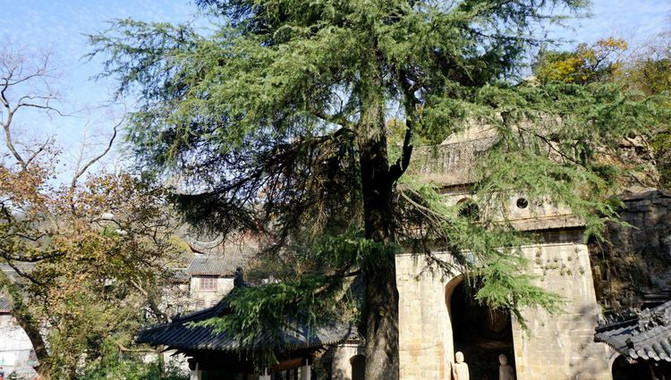

Qixia Mountain Three Sacred Temple Now "Wonderful Buddha Light" Since the "Wonderful Buddha Light" was discovered in the Three Sacred Temple of Qixia Mountain in 2009, the legendary "Wonderful Buddha Light" appeared again on November 22, 2009, from 15:17 to 15:43 pm, which lasted for 27 minutes. When the Buddha's light appeared in 2009, at first, a thin line of light appeared on the right cheek of the Buddha statue of Wuliangshou Buddha. As the light spot slowly moved, its shape also continued to change. Finally, the light spot shone impartially on the forehead of the Buddha statue. When it formed a fan shape. Because there is a crystal-like pearl between the eyebrows of the Buddha statue, when the light spot shone on the pearl, the pearl reflected brilliant colorful light and reflected on the top of the "Three Temples", and then mysteriously disappeared. This phenomenon appeared continuously at almost the same time in the following four or five days, but the trajectory of the "Buddha's light" moved differently from day to day, and the duration became shorter and shorter. Especially on the last day, the "Buddha's light" disappeared before reaching the forehead of Wuliangshou Buddha, and never appeared again. This strange phenomenon has also attracted more and more attention from tourists, which has attracted many devout Buddhists to come to pay homage to the film.

Many experts and scholars have put forward their own views on the emergence of this phenomenon. Some say it may be a coincidence, some say it is a man-made masterpiece, with different opinions. According to the "Annals of the Two Counties of Tongzhi and Shangjiang", the Wuliangshou Buddha in the "Three Sacred Temples" of Qianfo Rock "had" beads on the top and shot people."It later fell unfortunately and was taken away by the power at that time in the Song Dynasty. His whereabouts have been unknown since then. It can be seen that the "Wonderful Mysterious Light" of the Three Sacred Temples on Qixia Mountain has long been recorded in history. This shows that ancient Chinese skilled craftsmen were likely to use the subtle connection between the sun's sunshine and buildings to create some wonderful phenomena. Whether it is a natural coincidence or an artificial masterpiece, the most mainstream and convincing view is that the appearance of this phenomenon is related to the solar altitude angle in Nanjing in those days. It is a rare natural phenomenon, but it only appears in Qixia Mountain. This specific place of Qianfo Rock seems more "supernatural" and gives people more imagination.


Qianfo Rock is located at the southwest foot of Fengxiang Peak. In the seventh year of Yongming of the Qi Dynasty in the Southern Dynasties (489), the son of Monk Shao of the Ming Dynasty collaborated with Zen Master Zhidu to carve three sacred statues to commemorate Monk Shao of the Ming Dynasty. Shamao Peak was excavated in the Tang, Song, Yuan and Ming dynasties. Including the Southern Dynasties, there were 700 statues in total. The large Buddha statue is several feet high, and the small one is only a foot high. Among them, the "Big Buddha Pavilion" is the earliest and largest grotto dug. It was dug in the seventh year of Yongming in the Southern Qi Dynasty (AD 489). The sitting statue of Wuliangshou Buddha in the center is 12 meters high. The statue of the East Feitian Stone is in the No. 102 Buddhist niche. This niche is very small, with a total of 5 Buddha statues. The two groups of flying statues on the top of the cave are orange and the lines are clearly discernible. The flames above the middle Buddha statue are vaguely visible. Although there are only two pairs of flying birds, these are the easternmost "Dunhuang ruins" found in China.


After exiting the back door of Qixia Temple, we followed the Temple Houshan Road towards the main peak. Qixia Mountain is surrounded by mountains on three sides and faces the Yangtze River in the north. The mountain has three peaks. The main peak is Sanmao Palace, also known as Fengxiang Peak, with an altitude of 286 meters.
Qin Shi Huang Linjiangchu
The place where the First Emperor Linjiang is located on the north side of the middle peak. According to Sima Qian's "Historical Records" of the Han Dynasty, in 210 BC, Qin Shihuang toured the east and climbed Mount She (Qixia Mountain) when he returned north, demonstrating the unity of the four seas and the admiration of the ages. Built in the spring of 2006, this attraction is an antique building, including a double-eave pavilion, corridor, pavilion and viewing platform. It is an excellent place to review the river and range rover.


Since the Ming Dynasty, Peach Blossom River has long been famous for its peaches competing for beauty in spring. Sheng Shitai, a celebrity in Moling in the Ming Dynasty, said in "Qixia Mountain Annals":"At the end of spring and early summer, red and green shades fall around, and tourists walk down, and their clothes all have seasonal colors." At the end of the Ming Dynasty and the beginning of the Qing Dynasty, Li Xiangjun, a famous prostitute in Qinhuai, also lived in seclusion here. After her death, she was buried in the jungle by the Peach Blossom Stream. The Taohua Lake in the Taohua Stream is opposite Li Xiangjun's tomb across the road, surrounded by trestle bridges, ancient maples, peach forests, pavilions, lake water, Dielang Rock, Tiankai Rock, and Imperial Garden.






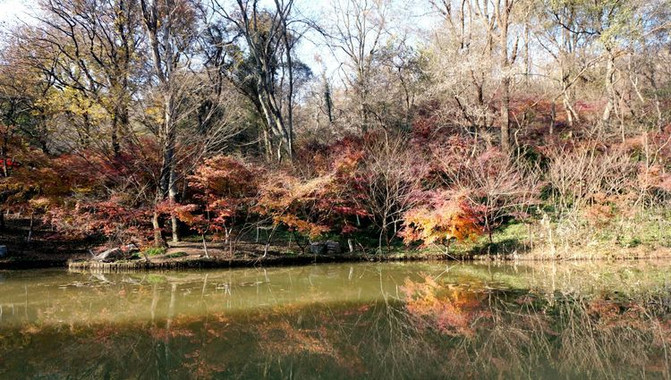
Qixia Mountain has three peaks, the main peak Fengxiang Peak is 286 meters above sea level; there is Longshan Mountain in the northeast; and there is Tiger Mountain in the northwest. Qixia Mountain is extremely rich in geological connotations, with many fossils of ancient organisms. It is the naming place for many geological names and is called the "Natural Geology Museum" and "Geoscience Textbook" by experts.
Fengling is located on the west side of Qixia Mountain. There are patches of maple trees. In Qixia in late autumn, the maple trees are covered with red leaves, making Qixia Mountain known as the "No. 1 Mingxiu Mountain in Jinling".
Qixia Mountain also has a number of natural wonders, which are very interesting. For example, in the northeast of Qixia Temple, there is a bluish-gray rock on the south slope of Pingtou. The surface is wavy. It is called the "Dielang Rock", which is very rare. In addition, there are natural wonders such as "Qingfeng Sword","Tiankai Rock", and "Yixian Sky" as well as Li Xiangjun's tomb.







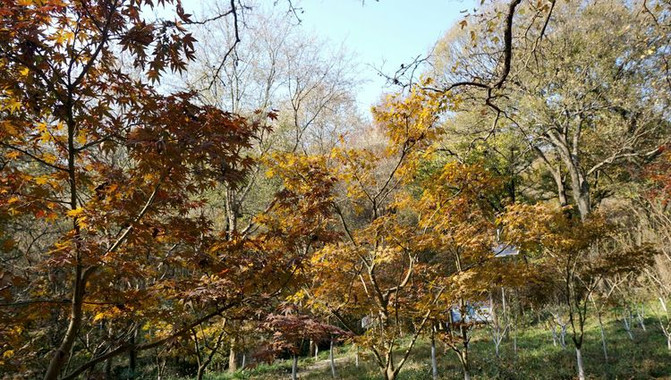




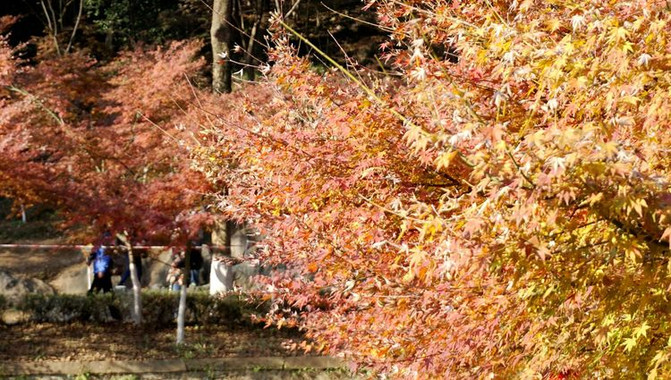

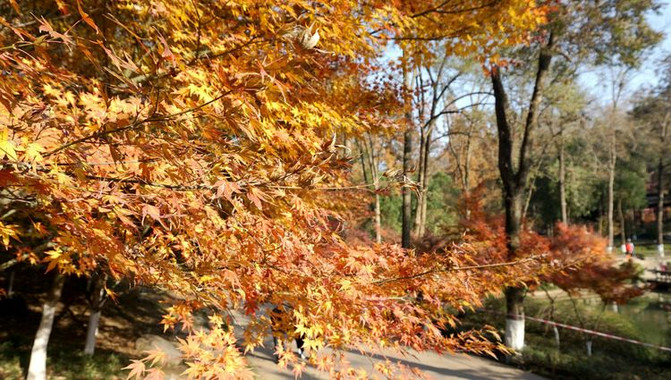



The Hongye Valley is located at the junction of the Imperial Garden and the southwest mountainside of Fengxiang Peak. Since it has been unvisited for many years, coupled with the erosion of mountains and rivers, the exposed rocks show the cliff and strange stone landscape. The rest are dense jungles and wetlands. The unique climate and environment make it rocky, ancient maples stand tall, and ancient vines intertwined here. The construction of this scenic spot fully considers the harmonious combination of landforms, water bodies, plants, facilities, etc., pays attention to the restoration of the ecological functions of Qixia Mountain, continuously beautifies, optimizes, and colorizes the environment, and diverts water to build ponds to improve the ecological environment of the area. The Red Leaf Valley covers an area of about 50,000 square meters. The scenic area has beautiful natural features and is characterized by strange rocks and red leaves. It is a new red leaf viewing area integrating mountains, stones, water, forests and pavilions.











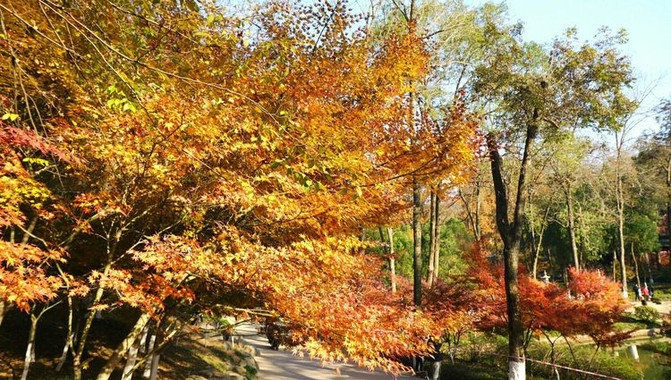




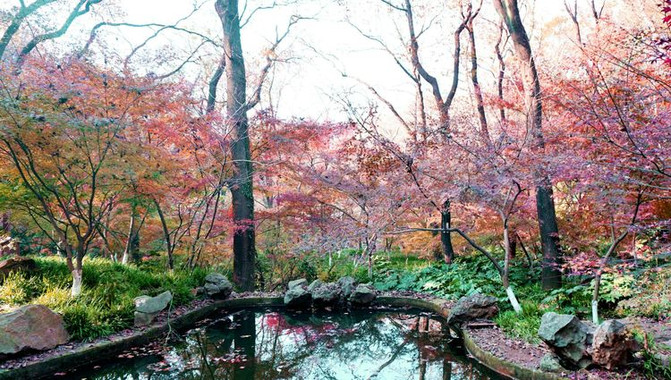


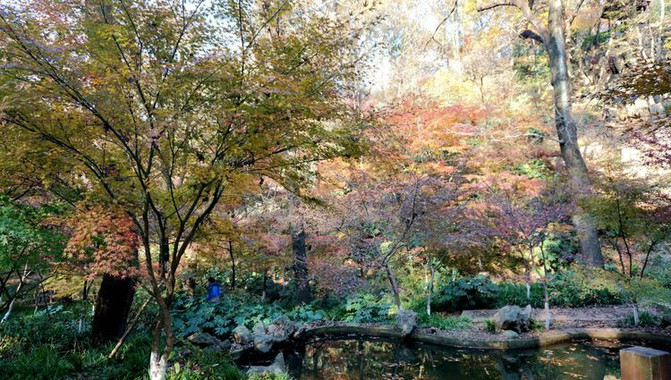

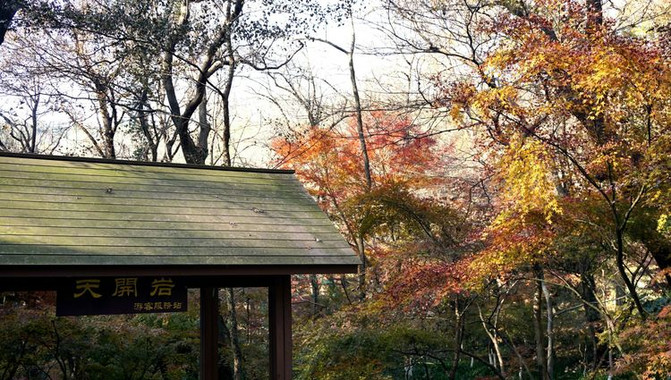








Spring tour, the head of the ox is in autumn, and the red leaves all over the mountains are like rosy clouds. The red leaves are intoxicating, and the layers of forests are full of beautiful scenery.



































































































